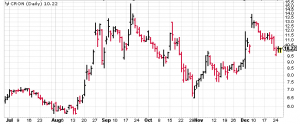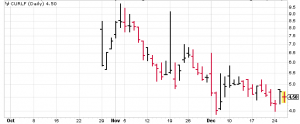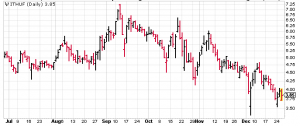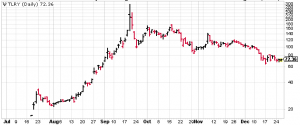Like the broad market, many of the stocks in the portfolio have had a rough time over the past month, as investors have been spooked by fears of inflation and trade wars. But as the end of the year approaches, so does the incentive to take losses for tax purposes, and my optimistic reading is that most of the marijuana stocks have bottomed—though it may take a while for uptrends to be reestablished
Cabot Marijuana Investor 1218
The End of a Big Year
If you were investing a couple of decades ago, at the height of the dot.com boom, you no doubt remember stocks like Pets.com, Earthlink.com, Homestore.com, E Greetings Network, Chinadotcom Corp, Juno Online, Women.com Networks, Rare Medium Group, Drkoop.com, Ask Jeeves, eCollege.com, Youbet.com, Book4golf.com, Hotel Reservation Network, VitaminShoppe.com, musicmaker.com, iParty and etoys.
When the boom went bust, all these stocks—and many more—imploded, and many of them died, and the legions of investors who had bought near the top simply saw their money disappear.
So the question worth asking today is whether many of the recently hot marijuana stocks will do the same.
My answer is no.
First, in 1999 and 2000, the market was at the tail end of an 18-year bull market that had truly drawn in the man on the street. Both the man who cut my hair and the man who cut my lawn were talking about their stocks and mutual funds. People were quitting their jobs to make money as day traders. In 2018, while we’ve been in a bull market for 10 years, the man on the street has nowhere near the same level of interest in investing.
Second, most of those internet businesses were ideas without much of a business behind them. But money was flowing freely, so businesses were created to take it. In April of 2000, there were 470 public companies in the various corners of the internet sector. The marijuana industry, by contrast, is not pie-in-the-sky; it’s existed for many decades! But it’s been underground, out of sight of the investment community. So a large part of today’s growth is simply the transition of that very real industry from black market to legal.
Third, the bull market in marijuana stocks that peaked in October was smaller than the bull market in internet stocks in every way: it had fewer investors in it, it had fewer stocks in it, its run-up was briefer and it didn’t go as high.
Yes, there are still a bunch of young companies in the marijuana industry today that will die. Of the 133 marijuana stocks I’m tracking, only nine are trading above 10 dollars a share and only 42 are trading above a dollar a share. A lot of those little ones will fade away.
But overall, my view is that the current correction in this sector is absolutely normal, that it will bottom as the broad market bottoms, and that the stocks of the leading companies in the industry—many of which are already posting triple-digit revenue growth—will be much higher a few years from now.
The Big Bounce
And what of yesterday’s humongous bounce, which brought the biggest one-day point gain in Dow history? First, it was due, just as the big correction of the past few months was due. Second, volume was light, thanks to the holiday, so it’s not as valid a signal as it could be. And third, it will almost certainly be followed—sometime—by a retest of the recent lows.
But in the long run, all the stocks of the leading marijuana companies will advance to new highs, because this is still the fastest growing industry in America!
So, to review our strategy once again:
Investing Strategy
- Practice the number one rule of successful investing—diversify. Don’t just buy growers. Consider the companies in distribution, packaging, real estate, etc. I’m still looking for a banker to the industry.
- Invest in sync with the trends of both the broad market and the marijuana sector. This year, the sector peaked in January 2018 and again in October 2018. The sector (like the broad market) is now on a correction and trying to build a base.
- Employ all the usual risk-reduction strategies. Diversify your buying over time, buy on dips, consider taking partial profits when stocks are extended (as we did the day before legalization in October), and cut losses short if you can’t tolerate holding big losses.
- Always be aware of your risk level, and the fact that big moves in either direction are likely, especially in the lower-priced more thinly traded stocks.
- Remember that this is a marathon, not a sprint; my goal is to get you invested in the marijuana stocks that will be the leaders of the industry years from now, even decades, and then to guide you to maximizing your gains while minimizing your risk in the years to come.
Legalization is On the March
President Trump has signed the Farm Bill, which legalizes hemp growing nationwide. South Korea recently became the first country in East Asia to legalize cannabis for medicinal reasons, and was followed closely by Thailand, so the global trend toward legalization, which actually began with Uruguay, continues.
The Marijuana Index
Marijuana stocks sank in sync with the broad market over the past couple of weeks, taking out the April and August lows before rebounding powerfully yesterday. From peak to trough, this correction took the sector down 45%, which is probably enough. And the good news is that when the index returns to its old high, it will deliver an advance of 82%! That’s something you definitely want to be part of!
WHAT TO DO NOW
If you’re new to the marijuana sector, ease in slowly. Stocks you can consider now are ACB, CURLF, ITHUF, IIPR, KSHB, OGRMF and TLRY. But if you’ve already established your position, stand pat and wait for the stocks to show more strength. In the portfolio, our cash position is now 15%, and that seems fine.
CURRENT RECOMMENDATIONS
The portfolio was started with a hypothetical $100,000 on August 22, 2017.
Aphria (APHA)
Aphria is the #4 grower in Canada by market capitalization, and I think it has a bright future. But an attack by short-sellers in early December took the stock as low as 3.75, and since then the stock has been building a base between 5 and 6. If you don’t own it, I like the idea of buying around 5. Fiscal second-quarter results will be announced on January 11, before the market open.
Aurora Cannabis (ACB)
Aurora is the #2 grower in Canada by market capitalization, it has funded production capacity of over 500,000 kg per year in Canada and Denmark, and earlier this month it announced a deal to acquire Farmacias Magistrales, which recently became Mexico’s first and only federally licensed importer of raw materials containing THC. In my update last week, I told you that ACB has a very healthy long-term pattern, with support at 5 dating back more than a year, and that’s still true today. If you don’t own it, you can buy here.
Canopy Growth (CGC)
With a market valuation of $9 billion, Canopy is the undisputed king of the cannabis industry, not least because of the $4 billion contribution of Constellation Brands (STZ), whose investment kicked off the August blastoff of all stocks in the industry. And earlier this month, the company announced a deal to acquire German vaporizer company Storz & Bickel for roughly $180 million. Storz & Bickel is widely recognized as the global leader in vaporizer design and manufacturing, serving both recreational and medical markets. It has an IP portfolio of 17 filed patents and has exported devices to 50 markets around the world, and Canopy sees this acquisition positioning the company for success in the next wave of federally regulated products in Canada beyond dried flower and edible oils.
As for the stock, as the leader in the industry, it became over-owned at the top, and weak hands are still selling. It’s a fine hold, but not a buy until a real bottom is established.
Cresco Labs (CRLBF)
Based in Chicago, Cresco is a U.S. multi-state retail operator, with operations in seven states and approvals pending in two more. Third-quarter revenue was $12.2 million, up 335% from the year before and 51% from the previous quarter. Earlier this month, the company announced the acquisition of Hope Heal Health, a Massachusetts company with a 150,000 sq. ft. growing facility and plans to obtain up to three medical marijuana dispensary licenses and three adult-use dispensary licenses in the state. Cresco’s market capitalization is the lowest in the portfolio, at just $125 million, and the stock is thinly traded so it’s higher risk, but there’s also higher potential for reward if the company executes well.
The stock came public on December 3 (fairly terrible timing), bottomed the next day near 4, peaked a week later at 6, and bottomed again just last week at 4.75. The portfolio bought last week on the day after that bottom and the stock has been up every day since. If you didn’t buy last week, I suggest waiting for a price closer to 5.
Cronos Group (CRON)
Cronos is the third largest by market capitalization of the Canadian marijuana stocks, in part because earlier this month, Altria Group paid $1.9 billion to acquire 45% of the company. Obviously, the maker of Marlboro knows how to sell recreational drugs.
And there’s an interesting lesson contained in the stock’s chart, which illustrates the value of the investing maxim, “Buy the rumor; sell the news.” On December 3, as rumors surfaced that Atria was in talks with Cronos, the stock surged 11% to close at 10.17. But it wasn’t until three trading days later, on December 7, that the companies announced their agreement—causing CRON to gap up wildly and close the day at 12.72. So, if you’d bought on the rumor, you would have seen a gain of 25% in those three days, while if you’d bought on the news, you’d be down 21% today.
The stock is clearly a solid hold, but if you don’t own it yet, I recommend waiting. Like CGC, the stock is still cooling off.
Curaleaf Holdings (CURLF)
Massachusetts-based Curaleaf is another U.S. multi-state retail operator, with 35 dispensaries, 12 cultivation sites and 10 processing sites in 12 states. Management is aiming for sales of $400 million in 2019. The company is the most highly valued of the U.S. multi-state operators, at $2.1 billion, so it’s not undiscovered, but the stock, which came public on October 29, seems to have bottomed.
In fact, CURLF first hit 4 on December 4, and retested that level this Monday. The portfolio bought last week, and if you didn’t buy then, you can buy now—or wait for a possible return to 4.
CV Sciences (CVSI)
CV Sciences is not in the marijuana business; instead it’s the number one seller of cannabidiol (CBD) oil, which is sold across the U.S. in health food stores, marijuana dispensaries and online under the brand Plus +CBD. And most CBD oil comes from hemp, a cousin of marijuana.
As for the stock, CVSI avoided the big selloff of the marijuana growers post-legalization (hooray for diversification), and its general pattern has been sideways since August, with a downward tilt in December. There are bottoms at 4, 3.5 and 4, dating back to early October, so the stock might be a good buy here, but I’d defer until we see clearer evidence.
HEXO Corp. (HYYDF)
HEXO is the Canadian marijuana grower that has partnered with Molson Coors to put cannabis drinks on shelves in Canada as soon as they’re legal—probably in 2019. Earlier this month, it reported fiscal first-quarter (ended October 31) revenues of $6.7 million, which included sales of $5.2 million of adult-use cannabis in the first two weeks of legalization in Canada. And just yesterday the company applied for a listing on the NYSE, which will increase accessibility to the stock. But the stock has been weak. It may have bottomed on Monday at 3—where the stock bottomed in August—but there’s still the potential for it to fall lower, to 2.5 where it bottomed in February.
iAnthus Capital (ITHUF)
iAnthus owns and operates growers, processors and dispensaries in six U.S. states—with a strong focus on the East Coast. And by the end of January iAnthus is expected to complete the acquisition of MPX Bioceutical, which will expand the company’s footprint to ten states (Arizona, California, Colorado, Florida, Maryland, Massachusetts, Nevada, New Mexico, New York and Vermont), with 56 retail locations and 14 cultivation/processing facilities.
As for the stock, it’s still working to find a bottom. Right now, the odds are on 3.5, so if you don’t own it, you can buy near there.
Innovative Industrial Properties (IIPR)
Innovative Industrial Properties is a real estate investment trust (REIT) dedicated to the cannabis industry. With the closing last week of a property in Barry, Illinois, the company has 11 properties in nine states totaling more than a million rentable square feet. It’s got a yield of 2.9%. Additionally, it’s one of the few companies in the portfolio with actual earnings. Thus, in this portfolio of young, volatile high-flyers, IIPR is a relative rock.
As for the stock, it soared in November, as investors rushed to safety, and it’s pulled back normally since, to just under its 200-day moving average. If you don’t own it, you could buy here or wait for a retreat down toward 40, where the stock bottomed in October.
KushCo Holdings (KSHB)
KushCo is another component of the portfolio that’s here for diversification away from growers as much as anything. The company provides containers for the industry, as well as the veterinary medicine industry. It offers design and branding services to complement its containers (many of them child-proof). It offers a wide array of industrial gasses to cannabis processors, so they can turn harvested product into oils and more. It has an office in China to gain better control of its manufacturing relationships there, and it has a Toronto-based subsidiary to begin to tackle the Canadian market. Plus, all these operations are legal nationally.
As for the stock, it bottomed in early September and has been trading between 4.4 and 6.6 since then. If you don’t own it, and you want more diversification in the industry, you can buy here.
MedMen (MMNFF)
MedMen is a major cannabis retailer in the U.S., and it’s getting bigger; when its acquisition of PharmaCann is complete, it will be licensed for 76 retail stores and 16 cultivation and production facilities in 12 states, serving roughly half the U.S. market.
And business is good! For the fiscal first quarter ended September 30, the company reported revenues of $21.5 million representing 1,094% revenue growth over the first quarter of fiscal 2018.
But last month the company botched a fund-raising deal, leading to greater dilution and the exit of the CFO, who has since been replaced by Michael W. Kramer, a veteran finance executive with a proven track record at retailers such as Apple Inc., Abercrombie & Fitch and Forever 21.
That snafu hit the stock hard in November and in December the stock bottomed near 2.5 numerous times, so if you’re feeling adventurous, you can buy near there. The stock has real potential to soar in January.
Organigram (OGRMF)
Based in the province of New Brunswick, OrganiGram is the smallest of my Canadian growers by market capitalization, and possibly the lowest-cost producer in Canada. It claims a leading market share position in the Maritime provinces of New Brunswick, Nova Scotia and Prince Edward Island with a strong presence in Alberta, Manitoba, Newfoundland and Ontario.
For fiscal 2018, ended August 31, Organigram reported revenues of $12.4 million, up 131% from the year before, and it expects to easily top that in the first quarter of 2019, thanks to the new adult-use market.
As for the stock, it’s been weak, but there’s support at 3 dating back to early this year, so that is likely to prove the bottom as 2018 winds down. If you don’t own it yet, you could buy some here.
Tilray (TLRY)
Tilray is a Canadian grower focused on the medical market, globally. It’s got a management team that impressed investors deeply early this year. And it was early to list on the Nasdaq, all of which combined to briefly put the stock at 300 in September—a peak from which it’s been retreating since.
Fundamentally, meanwhile, the company is still rolling. Just last Tuesday, Tilray announced an exclusive global supply and distribution agreement for medical marijuana with pharmaceutical giant Novartis (NVS). Novartis is not allowed to partner with another cannabis company, and Tilray cannot make a pact with another pharmaceutical business on non-combustible products. Then on Wednesday, the company announced a product research deal with AB InBev (BUD) that will explore non-alcoholic beverages that contain THC and CBD. That partnership is confined to Canada for now, and decisions about the commercialization of the research will be made in the future.
As for the stock, TLRY peaked on September 19, well before the sector’s October 17 peak, and it’s been cooling off ever since, and as the year heads toward a close, I see a base being built around 70. If you don’t own it, you can buy here.
Turning Point Brands (TPB)
Turning Point is the old-school smokeless tobacco company that has been expanding into the cannabis and vaping and hemp markets, all while paying a dividend supported by its mature but declining tobacco business.
As to the stock, it peaked in the 40s in September and October, and has corrected normally since. Last week I wrote, “much as I hate to say it, it looks like 22 is the next support level,” but that may have been too pessimistic, as the stock has rallied lightly in recent days and now looks like it might hold above 27 as we finish the year.
STOCKS ON WATCH
Charlotte’s Web Holdings (CWBHF 10)
Based in Colorado, Charlotte’s Web grows hemp and makes CBD—and claims to be the world’s leading brand by market share, with more than 3,000 retail locations. The stock came public in September and is now working on building a bottom. The stock is thinly traded, and the company is more famous than I’d like.
Origin House (ORHOF 4.2)
Previously known as CannaRoyalty, Origin House is a California-centric platform of holdings via royalty agreements, equity interests, secured convertible debt, and licensing agreements. The stock came public in June, peaked at 8.4 in early November, and has been correcting since.
Elixinol Global (ELLXF 1.8)
The stock is low-priced, but it’s going up—and that’s unusual today. Elixinoil is a Colorado-based hemp grower and CBD retailer.
THE NEXT CABOT MARIJUANA INVESTOR WILL BE PUBLISHED January 31, 2019
Neither Cabot Wealth Network nor our employees are compensated by the companies we recommend. Sources of information are believed to be reliable, but are in no way guaranteed to be complete or without error. Recommendations, opinions or suggestions are given with the understanding that subscribers acting on the information assume all risks. © Cabot Wealth Network. Copying and/or electronic transmission of this report is a violation of U.S. copyright law. For the protection of our subscribers, if copyright laws are violated, the subscription will be terminated. To subscribe or for information on our privacy policy, call 978-745-5532, visit www.cabotwealth.com or write to support@cabotwealth.com.

















